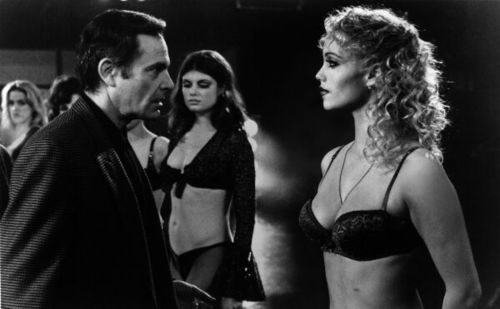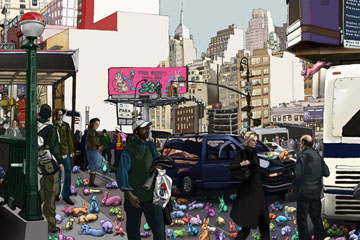Wes Anderson and Jason Schwartzman, “Live at 01”
“Recorded entirely on location at
Borders Store 01
Ann Arbor, Michigan”
I was almost too busy rolling my eyes at these two smug knuckleheads doing a promotional prowl of the CD and DVD aisle to notice the real eyeroller: the corporate reverence for “01” as if a giant, shitty, homogenized bookstore can somehow be unique because it’s the one they’ve cloned everywhere else. [via fimoculous]
Category: movies
The Post-Apocalyptic Open-Pit Mines Are Alive With The Sound Of Music

Alright, so last night I made some wisecrack about a scene from Kevin Costner’s 1997 film The Postman, where a mutant general pacifies his slave army by showing The Sound of Music on a floating theater on a lake at the bottom of an open-pit mine, might be a mashup of a couple of Robert Smithson’s unrealized installations. Little did I know.
I rewatched the scene just now, and it’s positively Smithsonian. I remembered some things incorrectly. [I hadn’t seen the movie since Christmas Night, 1997, when I had a private screening–on what turned out to be opening night, whoops–at a desolate multiplex in Salt Lake City.] Like I’d forgotten how spectacular it is, really well-crafted and poetic, even, for what amounts to a single note in the film [hats off to cinematographer Stephen Windon and the wonderfully named production designer Ida Random].
And the slave soldier army isn’t floating around, watching; they’re perched on the tiers of the open pit mine; I got that mixed up with the harborside cinema scene in Cinema Paradiso: in The Postman, only the projectionist is floating, in his little booth that looks like the offspring of Smithson’s Floating Island and his Partially Collapsed Shed.
I’d also forgotten completely about Dolph Lundgren. As the scene opens, and the ersatz movie theater is revealed, the screen first fills with explosions, the opening credits of Dolph Lundgren’s Universal Soldier. But–unexpectedly!–the crowd of soldiers revolts and starts raining rocks down on the poor projectionist in his floating booth. He quickly changes the movie [beat] to The Sound of Music, and the mob is subdued.
In his Cinema Cavern, Smithson wanted to show only one film, Film On The Making [of] Cinema Cavern. But after a long day of killing in the mines, the “ultimate film-goers” in The Postman reject their own “making of” film, preferring instead the escapist fantasy of Julie Andrews, the singing, Nazi-thwarting nun.
Anyway, there are a bunch of tasty screencaps on flickr and after the jump. Enjoy.
previously: “truly ‘underground’ cinema”
Continue reading “The Post-Apocalyptic Open-Pit Mines Are Alive With The Sound Of Music”
“Truly ‘Underground’ Cinema”

I loved Cabinet before I wrote for them, and I love them after. In the latest issue, #30 The Underground, Colby Chamberlain looks at an awesome 1971 drawing by Robert Smithson titled, Toward the development of a Cinema Cavern or the movie goer as spelunker. [Colby’s piece is not online, but Smithson’s complete drawing is at the Estate site.]
According to a contemporaneous Artforum essay titled “A Cinematic Atopia,” Smithson described the project:
What I would like to do is build a cinema in a cave or an abandoned mine, and film the process of its construction. That film would be the only film shown in the cave. The projection booth would be made out of crude timbers, the screen carved out of a rock wall and painted white, the seats could be boulders. It would be a truly “underground” cinema….
Smithson’s interest in cinema was phenomenological: the idea that you sit there, motionless in the dark, experiencing a continuous stream of light and sound patterns. The Cinema Cavern’s closed, self-referential loop devolves into an abstract, multi-colored blur, with the “sluggish,” sloth-like movie goer none the wiser.
Colby puts Smithson’s cinema into context with the Underground-brand cinema of the day, as embodied by Stan VanDerBeek, Jonas Mekas, and friends. Which is fine and all; meanwhile, I’ve added the Cinema Cavern to the list of sketchy Smithson ideas I’d love to see realized here and now.
Part of me–the part who, admittedly, has not delved into the Smithson archives, and thus doesn’t know more than the single sketches–sees the Cavern Cinema as just as fully developed and thus, valid for realization, as, say, Floating Island. And part of me is still smarting for not getting to Les Arennes de Chaillot, the subterranean theater and couscous boite built in Paris by la Mexicaine de Perforation, a group of explorateurs urbains. [read my 2004 LMDP interview here.] And

Also on the list: the 1973 Bingham Copper Mining Pit – Utah Reclamation Project. Smithson called for a giant, revolving viewing platform at the bottom of Kennecott Copper’s mountain-sized hole on the western side of Salt Lake Valley, all the better “to survey nature’s gradual and inevitable reclamation of man’s invasive enterprise” with, my dear.
[Every time I fly into Salt Lake, I’m reminded of this drawing/collage, which I rather impulsively bid on–and lost–when it came up for auction in 1993. I later met and became friends with the winning bidder, but I suspect I lost my chance at the drawing; its next stop will most likely be a museum.]
But what if Smithson’s visions already have been realized, and I just didn’t realize it? What if the Cinema Cavern and the Bingham Copper Mining Pit were combined and installed in the post-civilizational, entropic future, offering a front-row seat to nature’s reclamation?
I don’t know if it’s in David Brin’s original mid-80’s sci-fi novel, but in the 1997 film version of The Postman, the dopey title character, played by Kevin Costner, has a showdown with a “hypersurvivalist militia leader named General Bethlehem [played by Will Patton.] In one of the funniest scenes in the unintentionally hilarious fiasco, Bethlehem pacifies his troops–scraggly, murderous slaves who float around on rafts and inner tubes in a giant, water-filled, open-pit mine–with movies. As the battered projector whirs to life, the a battleworn print of The Sound of Music
PDF of “A Cinematic Atopia” in portuguese and english [sescsp.org.br]
Cinema Cavern, 1971 – Robert Smithson Estate – Drawings [robertsmithson.com]
I See Dead Careers
I haven’t watched an M. Night Shyamalan film since I made the mistake of watching The Sixth Sense twice. So every time one comes out, I have to wait for someone to reveal the gimmick. That one with Joaquin Phoenix took forever. [They live in the present! Deal with it!]
Finally, someone is catching on, though I worry it comes too late, just as Shyamalan’s career is committing elaborately choreographed, ominously lit suicide. Christopher Orr’s review of The Happening is exactly what I want: a giant list of ridiculous spoilers so people don’t have to see the crappy movie. One of many best lines:
It’s like the climax of Twister, without the twister.
[via jason]
Yeah, Bubby!
“Sex, for Zohan, is like hummus: there is an endless supply, and no occasion on which it could be judged inappropriate.”
– Anachronistic taste, hedonism, international man of mystery, yet AO Scott’s review makes no mention of Austin Powers at all. Is it a Jewish conspiracy, what?
Janet Jackson, Paula Abdul. Herbert Muschamp Is What The World Trade Center Is All About!

Choire’s interview with Elizabeth Berkley reminded me of some unfinished Showgirls business here on greg.org.
Back in 2002, right after Beyer Blinder Belle released the first, banal master plans for the rebuilding of the World Trade Center site, a parody critique circulated in the style of Herbert Muschamp, then the architecture critic for the NY Times. Finally, here it is:
A Critical Appraisal
Special to The New York Times
Striding down the row of design proposals for the World Trade Center site, balefully eyeing each inert mien and artificially enhanced plan, I was reminded of the scene in Showgirls where the choreographer grimly surveys his topless charges. Flicking a feather across their assembled nipples, he scolds, “Girls, if you are not erect, I’m not erect.”
Ladies and gentlemen, I’ve seen the master plan proposals from the Lower Manhattan Development Corporation, and, to put it mildly, I’m not erect.
My heart sank as I watched John Beyer of the architectural firm Beyer Blinder Belle attempt to describe these hapless proposals. I was painfully reminded of another much more casual presentation one glorious autumn on Capri. The visionary Rem Koolhaas was holding forth on urban planning, shopping, life, and the smell of fresh basil. Wearing beautifully tailored trousers and a tight, cropped black top (need I add it was by Prada?) he gestured energetically as he spoke. With each gesture, his shirt rode up ever so slightly, revealing a tantalizing sliver of tan, taut tummy.
It is this kind of energetic gesture that those of us who care about contemporary architecture hunger for so desperately. Beyer Blinder Belle’s work is occasionally competent: certainly their by-the-numbers renovation of Grand Central Terminal pleases the hordes of moronic commuters who stream through it each day, but it will come as no surprise that this recidivist pile of marble is of little interest to the infinitely more important audience of attractive young European architectural students who make pilgrimages to our city each year and can barely choke back their tears of disappointment. John Beyer, whose exposed torso would be unpleasant for even the more adventuresome New Yorker to contemplate, must shoulder the blame for this catastrophic failure.
It is now time to list these names: Frank Gehry, Peter Eisenman, Zaha Hadid, Elizabeth Diller and Ric Scofidio, Tod Williams and Billie Tsien, Steven Holl, and, of course, Rem Koolhaas. There.
Is a little daring, a little excitement, a little sexiness too much to ask for on this sacred site? Lower Manhattan Development Corporation chairman John Whitehead and New York governor George Pataki would do well to rent a videotape of “All About Eve” and examine Bette Davis’s behavior before the big party scene. Her character Margo Channing reaches into a candy dish and hesitates again and again before finally popping a candy into her mouth. This tantalizing motif “impulse, surrender, gratification” is the central one of the twenty-first century. It alone must provide the ideological blueprint for all architectural work being done anywhere in the world, including lower Manhattan. If this fails to make sense to the theme-park obsessed corporate apologists for big business, so be it.
In the interest of full disclosure, my proposal for the site will be revealed at a time and place of my choosing. Fasten your seatbelts, New York.
Ignore, if you can, the glaring error that Muschamp would never have made: the choreographer used ice cubes, not a feather. The irony is that not only did Muschamp’s writing the last few years before his too-early death seem to cut loose, as if to meet his parodists in the sky, the fake WTC critique turned out too true by half: thanks to a sycophantic 1776 minstrel show from Daniel Libeskind and a chorus line of starchitects flashing their tits, the Port Authority’s original proposal is right on track.
[via mouthfulsfood]
Previously: Surely, Hordes of Showgirls-Googling Architects Can’t Be Wrong?
NYT’s Box Office Visualizer: The Ebb & Flow Of Movies
Not to get all Kottke about it, but I really like the NY Times’ infographic data visualization tool thing [is that an inexpert enough description for you?] that plots out the inflation-adjusted weekly domestic box office numbers of movies from 1986-a couple of weeks ago.
It’s fun to play with and interesting to watch in the same way the highly addictive Baby Name Wizard’s NameVoyager interface is.
Still, I think Ebb & Flow’s got some near misses in terms of usefulness. The tool’s big takeaways–that studios are relying more and more on blockbusters, that there are more films released, for much shorter runs–are best seen over the years, so a zoomout would’ve been nice. Also, a zoom in, since so many recent films are reduced to single, stubby lines.
And while I’m sure it was a decision based on the underlying value of the box office data–as provided by NYTimes Company subsidiary StudioSystems and Box Office Mojo–the details I want to click for are not a synopsis and a link to the Times’ review; it’s the box office numbers and the duration of the theatrical run for that particular film.
Also, Idiocracy isn’t in there. I wonder why, since despite Fox’s best efforts, the movie was technically released last year. [Note to self: next time I see Mike Judge, give him $20 for downloading the movie in a way that provided absolutely no financial benefit to the studio who killed it.]
The Ebb and Flow of Movies: Box Office Receipts 1986 – 2007 [nyt]
It’s A Small Warhol’s World
I’m still looking around for anyone who gave an account of yesterday’s discussion of Warhol films at the American Museum of the Moving Image. Warhol Film Project director Callie Angell and film critic Amy Taubin were supposed to “discuss the artistic significance of Warhol’s films, the social and cultural milieu surrounding their production, and the history of their reception and their restoration.”
If you see something, please say something.

still from Inner and Outer Space, 1965
And as for the AMMI’s ongoing Warhol’s World film screening series, you should definitely see something. There are several reels of Screen Tests being shown. On Nov. 3rd, Saturday afternoon, a new print of Outer and Inner Space, the innovative double image, video-on-film portrait of Edie Sedgwick is screening. After that is a new print of Chelsea Girls. And the next week, Nov. 11th, is a new print of Lonesome Cowboys, which stars–among other people–Allen Midgette, the actor who pretended to be Andy during a 1967 speaking tour of western university campuses.
Warhol’s World – Screenings & Events, through Nov. 11th [movingimage.us]
Previously:
Have you seen me? Warhol’s lost videos
The Fake Warhol Lectures
NYC Bunnies Multiplying Like Rabbits


Whoa, so it turns out that Sony’s new Bravia ad full of city-hopping bunnies [top] is a ripoff of the LA-based design team kozyndan.
According to Core77, Sony’s commercial production company Passion Pictures had invited kozyndan to present their portfolio which, in addition to the bunnyscape panorama USA-chan [detail above], also included Uprisings, their Hokusai-inspired wave of bunnies. After receiving the materials, the agency never called the designers back.
[Dumb-ass smart-alecks like 95% of the commenters on Gizmodo take note: there is a substantive economic and ethical difference between kozyndan openly referencing a centuries-old, famous work of art by a long-dead artist and an ad agency taking tens of millions of dollars from a client for creative concepts and work it solicited privately from independent artists, and then used without either credit or compensation.]
This also seems like a good time to point out that Sony’s agencies appear to have a problem with this. The idea of the first big Bravia ad, the one with 250,000 bouncy balls let loose on the street, was originally exhibited in Canada and the UK by the Canadian artist Lucy Pullen .
[Not that Sony’s alone in this ripoffery. Apple was in touch with artist Christian Marclay to use his 1995 piece, Telephones, for the first iPhone commercial that ran during the Academy Awards. Marclay finally refused, but Apple went ahead anyway.]
Will the Real Bunnies Please Stand Up? [core77]
HOLY CRAP, FRED KAPLAN, SPOILER ALERT?!
Yeah, so how about that Blade Runner: The Final Cut article in the Arts & Leisure section??
A Cult Classic Restored, Again [nyt]
Ten Top Ten Lists Of Video/Films For The 21st Century
The Japanese magazine Art-iT asked ten artists, directors, curators and i-don’t-knows for their top ten “‘artistic’ films of the 21st century”. I was glad but just a little surprised to see Jeremy Blake’s Sodium Fox, which I don’t think was as good as Winchester.

And I was pleased to see Takehito Koganezawa, whose Untitled (Neon) plays like a documentary Jeremy Blake. I’m surprised that no one put Christian Marclay’s Video Quartet on a list, but not as surprised as I was that they put anything of Bill Viola’s. Ugh. But the most 21st century list of all is probably Ukawa’s, because as you know, if it’s not on YouTube these days, it doesn’t exist.
The Listmakers:
Kataoka Mami
Kurosawa Kiyoshi
Barbara London
Hans Ulrich Obrist
Johan Pijnappel
Sawa Hiraki
Mike Stubbs
Ukawa Naohiro
Apichatpong Weerasethakul
Elga Wimmer
10×10 “artistic” films of the 21st century [art-it.jp via jeansnow.net]
That Was Way Harsh, Times
From the NYT review of Bratz: The Movie:
With their tender hearts and lip-gloss dreams, these teenage princesses are direct descendants of Alicia Silverstone’s Cher in “Clueless,” although Sean McNamara’s TV-ready framing and coarse direction lack Amy Heckerling’s snap and style.
As if. Clueless was like the greatest Jane Austen adaptation Hollywood’s ever done. Bratz are a line of skank dolls for whorish toddlers with–oh. Clueless parents.
UbuWeb Sitdown With Archinect
There’s an excellent, loong interview on Archinect with Kenneth Goldsmith, the artist, poet, dj, theory karaokeist [?], professor, and web developer behind the incomparable UbuWeb.
Ubu began with just texts, and as collections and formats and partners came their way, it’s expanded into other media: sound, performance documentation, artist film and experimental video. The focus remains resolutely on the undeservedly inaccessable and out of print/circulation.
Goldsmith: “My only regret though is that there aren’t fifteen or twenty UbuWebs.” They talk about theater, dance, and architecture Ubus, but I confess, I have a hard time seeing how those might come together as well as Ubu’s collection of conceptual/concrete poetry. Could happen, though. Anyone have some unlimited bandwidth and server space? There may be a MacArthur in it for you.
UbuWeb Vu – Kenneth Goldsmith [archinect]
My Quarters With Conrad
A short film Noah Baumbach made in 2000, Conrad And Butler Take A Vacation, was included on the Criterion edition of Kicking and Screaming. Variety was not pleased with this story of two buddies, one damaged from his divorce, getting annoyed and drunk on some sofas: “with grade-Z production values, this esome lark serves only one purpose: It proves just how far Baumbach has come.”
I don’t think it’s that bad, though, kind of carefully written, in fact. The short’s on YouTube, broken up into three 10-minute parts. At the moment, Part 1 has about 700 views. Part 2: 300, and Part 3: 250.
This vote-with-your-eyes data feels like a more useful assessment than Variety’s snark, especially if everyone who started watching was looking for Baumbach or Wes Anderson in the first place. [via coudal]
Grindhouse Lives Up To It’s Name
Jason caught a Guardian article saying that the Weinsteins are going to split Grindhouse in two: “There have been reports that many film-goers have been confused by the movie’s structure – mistakenly assuming that there was only one film on offer and leaving the cinema en-masse after the Rodriguez section.”
Having seen Grindhouse on opening night, I can only suggest the obvious: maybe people are leaving early because Rodriguez’s film sucks and blows simultaneously, and they’re trying to cut their losses?
Tarantino’s film is infinitely better, even in the trashfilm terms the two movies purportedly want to be judged on. I wish I’d gone to the previous showing of Deathproof, hung out in the lobby, then sneaked back into catch Planet Terror. Which I’d have then left early. Oy.
Grindhouse to be sawn in two? [guardian via kottke]
